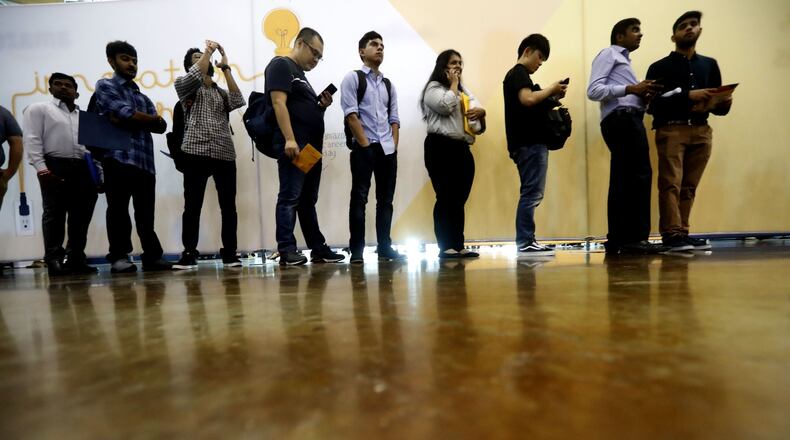Editor’s note: This article has been updated with additional details.
Georgia’s unemployment rate inched down to 3.3% in November, the lowest level since the government started keeping track in the 1970s.
The record was reached after the state economy added 6,500 jobs last month, slightly fewer than average for November, the Georgia Department of Labor reported Thursday.
Hiring has continued despite trade tensions and political uncertainty, at least partly because low interest rates and economic growth buoyed spending ahead of the holidays.
The record-low unemployment rate in Georgia also came despite growth in the labor force, an indication that companies were able to soak up most job seekers.
In October, the state’s unemployment rate had dipped to 3.4%, matching the previous low notched in 2001 toward the end of the tech boom.
“It’s nice to see this at the end of the year,” said Mark Butler, state labor commissioner. “I think we are going to continue to see Georgia move in the right direction.”
Georgia closely tracking U.S. trend
Georgia this year has added 60,900 jobs. While that is weaker growth than in any of the previous seven years, it is the 10th consecutive year of adding jobs, paralleling the nation’s record-long expansion.
During that span, the state’s jobless rate has steadily slipped from a painful high of 10.6% to levels unseen since the boom of the late 1990s – and even then, 3.4% was the lowest low.
The state’s growth in November paralleled the nation’s.
Two years ago, Georgia was adding jobs more rapidly than the U.S. as a whole, with the state’s payrolls growing more than 2% a year. Since then, job growth has continued, but the pace has slowed.
In the past 12 months, the U.S. has added 2.2 million jobs, growth of 1.5%. During that period, the state has added 69,000 jobs, growth of 1.6%.
The national unemployment rate last month was 3.5%, the lowest since the early 1950s, when the rate fell as low as 2.6%. No comparative data are available for Georgia because the government did not begin calculating the state rate until 1976.
Labor force participation rate still below 1990s peak
A very low unemployment rate does not mean that almost everyone of working age has a job.
The rate is based on the roughly 5.1 million Georgians in the workforce, who either have jobs or are seeking work. The number of unemployed – about 167,000 – includes only those actively seeking work.
But there are tens of thousands of Georgians who are not working while not being counted as unemployed. That group includes those who have given up looking, as well as people who are disabled, in school or are primarily caregivers to children or parents.
To get a better picture, economists often refer to the “labor force participation rate,” the share of working-age people actually in the labor force.
At its peak in the late 1990s, that labor force participation rate was nearly 70%. It is now about 62%. If participation were back at the peak, several hundred thousand more Georgians would have jobs.
Holiday hiring gives year-end boost, despite slow wage growth
The last quarter of the year is often strong for job growth, thanks to holiday hiring, as consumers open their wallets ahead of Christmas.
Last month, the sector that includes retail and logistics led the way in Georgia, adding 3,200 jobs in stores, trucking, warehouses and delivery.
Construction, which had been showing signs of weakness for several months, was also strong in Georgia, adding 2,300 jobs during November.
A recent survey found companies are less than optimistic about the economy, said Colleen Madden Blumenfeld, spokeswoman for the national outplacement firm of Challenger, Gray & Christmas.
But economist Nick Bunker of Indeed, a website for job searchers, said that surveys are not as important as actions – even when the help wanted signs are not as plentiful.
“Job openings have slowed down, while hiring has actually held up,” he said. “We are seeing more hires per job opening.”
The quality of jobs remains problematic, since logistics and retail tend not to pay well, he said. “Wage growth is not too strong. But if job growth continues into 2020, then we’ll see wage growth pick up again.”
Overall wage increases have been modest throughout the expansion, but pay in many jobs has notched up, largely because of scarcity of workers.
As the unemployment rate falls, continued hiring does draw some people back into the work force, but many companies do struggle to find specialized skills, said Kim Wallace, executive vice president of Hire Dynamics, an Atlanta-based staffing company.
“The job market is tight,” she said. “The hardest to find are maintenance mechanics. The higher skilled positions are the most difficult.”
Georgia job gains, Jan.-Nov.
2011: 40,000
2012: 67,700
2013: 80,600
2014: 120,700
2015: 94,600
2016: 90,100
2017: 62,200
2018: 81,800
2019: 60,900
Georgia unemployment rate
Highest: 10.6% (Dec., 2010)
Lowest: 3.3% (Nov., 2019)
Georgia unemployment rate, November
2010: 10.6%
2011: 9.9%
2012: 8.8%
2013: 7.7%
2014: 6.6%
2015: 5.6%
2016: 5.3%
2017: 4.3%
2018: 3.7%
2019: 3.3%
Sources: Bureau of Labor Statistics, Georgia Labor Department, St. Louis Federal Reserve
About the Author
Keep Reading
The Latest
Featured


